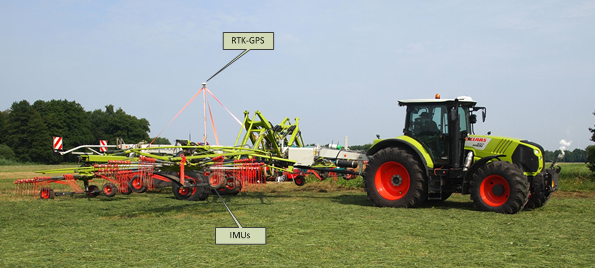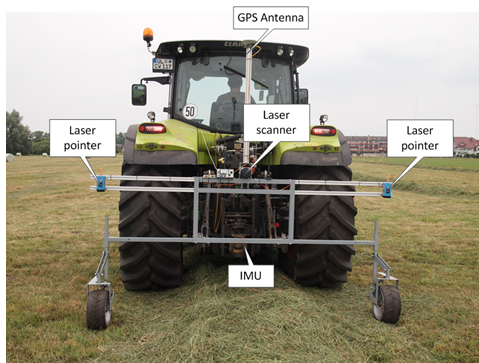Table of Contents
Research on fatigue life of agricultural machinery
Load measurements and surface profile mapping for assessing fatigue life of agricultural machinery
Involved persons
Prof. Dr. Hans W. Griepentrog
Dr. Dimitrios Paraforos
News
22.07.2016 - Successful defense of the doctoral thesis
26.06.2016 - Journal paper published in Biosystems Engineering Methodology for designing accelerated structural durability tests on agricultural machinery
07.11.2015 - LAND.TECHNIK AgEng 2015 Methodology for accelerated durability testing of agricultural machinery
26.10.2015 - Journal paper published in Journal of Terramechanics Country road and field surface profiles acquisition, modelling and synthetic realisation for evaluating fatigue life of agricultural machinery
26.03.2015 - “Country road and field surface profiles acquisition, modelling and synthetic realisation for evaluating fatigue life of agricultural machinery”, journal paper submitted
21.11.2014 - Road measurements in Bad Saulgau
08.10.2014 - Road measurements with the swather in transport conditions
23.09.2014 - International Conference ISTVS 2014 Surface profiles acquisition for assessing fatigue life of agricultural machinery in test facilities
28.08.2014 - Journal paper published in Biosystems Engineering Fatigue life assessment of a four-rotor swather based on rainflow cycle counting
04.07.2014 - Experiments were performed on 7.5 ha fields swathing straw
20.03.2014 - Conducting experiments at the DLG Test Center
21.02.2014 - “Fatigue life assessment of a four-rotor swather based on rainflow cycle counting”, journal paper submitted
08.11.2013 - LAND.TECHNIK AgEng 2013 New methodology to assess and test the durability of agricultural machinery
31.07.2013 - Experiments were performed on 10.5 ha grass fields
23.07.2013 - Experiments were performed on asphalt, farmer roads and 4.5 ha grass fields
Introduction
During the last decades fatigue life of agricultural machinery is gaining more interest as the transport and working conditions have changed. Transport and working speed have increased since advanced and more powerful tractors are being offered. In order to compensate for longer operation periods on large farms, manufacturers have developed bigger implements with higher capacity which in some cases e.g. for swathers reach up to 15 meters working width. Factors like higher speed and machine weight affect the durability of agricultural machines with high economic loss in the case of a breakdown. In order to assess agricultural machine durability a new analysis approach is needed to combine field and road surface mapping and dynamic strain and load measurements. In the present paper strain data from critical points of a four rotor swather were recorded as well as the accelerations on the main axle.
Aim & Objectives
Aim of the present project is to develop new methods that analyse fatigue conditions from the perspective of commercial design and test engineering. The principles are based on measuring field and road surfaces as well as detecting and determining the load spectra. The main objective is to be able to perform accelerated structural tests on the implements simulating their transport and working life in test facilities, establishing concrete knowledge about the fundamental parameters that really affect fatigue life.
Methods
The first stage includes the use of the implement in the real world under transport and working conditions where road and field surface data, swather wheel axle accelerations and the load spectra in frame profiles are obtained. Subsequently, the implement is used in test facilities where data from the same sensors are acquired. Having surface data in combination with the parameters of the wheels, mathematical modelling can be used in order to output the same wheels accelerations as the measured ones. The same procedure can be followed also to calculate the strains and forces that are applied on the chassis of the implement having as input wheels accelerations.

Material
For measuring the load spectra, twenty eight linear 350 Ohm strain gauges (LY1x, HBM GmbH, Darmstadt, Germany) were placed at critical points of the swather chassis which are regarded to bare higher stress. Data acquisition was performed using a DEWE-50-USB2-16 (DEWETRON GmbH, Grambach, Austria) system with sixteen channels. Each channel utilized a BRIDGE-A module (DEWETRON GmbH, Grambach, Austria) able to connect to strain gauges in a quarter, half or full bridge configuration. Twelve of the sixteen channels were connected with the uniaxial strain gauges in a quarter bridge configuration. The rest four channels were connected with the load measuring strain gauges in a full bridge configuration (in every channel four strain gauges forming a Wheatstone bridge).

In addition, two Inertial Measurement Units (IMUs) (VN-100, VecorNav, Dallas, USA) were utilized one after each wheel of the implement sensing the accelerations on the main axle. An RTK-GNSS system (AgGPS 542, Trimble, Sunnyvale, USA) attached on the swather provided georeference of the acquired data

In order to measure road and field surface profiles, a sensing system has been developed that mounts all the needed sensors. This construction utilized a metal frame which was mounted on the tractor’s rear three point hitch and two wheels which followed the path that swather wheels where moving on, to be able to acquire the surface profile of each track. The diameter of these two wheels was 350 mm in order to measure the surface with adequate accuracy. Two DT500 laser pointers (SICK AG, Waldkirch, Germany) with ±3 mm accuracy were measuring the surface elevation provided by the two wheels and an LMS 111 laser scanner (SICK AG, Waldkirch, Germany) was used to scan the entire surface. An AgGPS 542 RTK-GNSS system (Trimble, Sunnyvale, USA) was also used to provide georeference of these surface data while a VN-100 inertial measurement unit (VecorNav, Dallas, USA) was utilized to provide dynamic tilt information.
